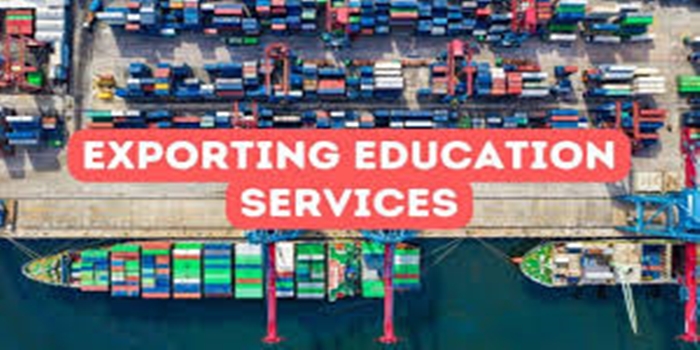In this article, we discussed exporting educational services, forms and channels of exporting educational services, economic and strategic importance of educational exports, emerging trends in educational services exports.
Definition
Exporting educational services includes selling and delivering education to foreign students and organizations, often driving economic development and a country’s global competitiveness. Key methods include transboundary delivery through online platforms, commercial presence via foreign branches or campuses, and the “presence of natural persons” through teacher mobility. The growth of digital technology and the globalization of higher education have made this a significant and expanding “global business
Forms and Channels of Exporting Educational Services:
Distance/Online Education: Courses, degree programs, and professional training delivered via the internet, email, or other telecommunication technologies. This includes self-paced online courses, virtual classrooms, webinars, Massive Open Online Courses (MOOCs), and e-learning modules.
Educational Materials: Exporting digital and physical educational materials, resources, and testing services.
Twinning/Franchise Arrangements (partial): In some cases, the foreign institution provides course materials, quality control, and evaluation to a local institution without establishing a full commercial presence, which can involve elements of Mode 1.
This is the most traditional form, where the consumer (the student) travels to the country of the service provider to receive the education.
International Student Mobility: Foreign students enrolling in full-time programs at educational institutions (e.g., universities, colleges, language schools) in another country.
Study Abroad Programs: Short-term exchange programs, internships, and study tours for students in a foreign country.
This involves a foreign service supplier establishing a commercial presence in the territory where the service is supplied, often through foreign direct investment.
Branch Campuses: Establishing physical satellite campuses of foreign universities or colleges in another country.
Joint Ventures/Partnerships: Collaborations between a foreign and a local institution to offer programs.
Foreign-owned Institutions: Establishing a local university or a private training company that is foreign-owned (e.g., language training centers, corporate training providers).
Franchising/Twinning Arrangements (full): The foreign institution licenses its curriculum and name to a local provider that establishes the physical facilities and hires staff, all while maintaining the foreign institution’s quality standards.
This mode covers the temporary movement of individuals who are service suppliers (e.g., teachers, professors, researchers) to another country to provide educational services.
Academic Mobility: Professors, lecturers, and researchers working abroad on a temporary basis for teaching or research.
Consulting/Expert Services: Educational consultants, specialists, or corporate trainers providing short-term services or advanced training courses in a foreign country.
International School Staff: Teachers moving abroad temporarily as employees of a foreign institution established in that territory.
Economic and Strategic Importance of Educational Exports:
Significant Revenue Stream: The export of educational services is a major source of foreign exchange earnings, often ranking among top service exports for host countries.
Support for the Wider Economy: International students spend heavily on living costs (accommodation, food, travel, tourism), generating substantial economic activity and supporting non-education sectors, such as retail and hospitality.
Job Creation: The education export industry creates employment opportunities within educational institutions (faculty and staff) and in associated support services.
Stimulates Economic Growth: The direct spending and wider spillover effects of international education have a positive, long-run dynamic effect on the host country’s economic growth and employment levels.
Funding for Domestic Education/Research: Revenue generated from full-cost international tuition fees can cross-subsidize the teaching of domestic students and vital research activities, especially in high-cost fields like science and engineering.
Human Capital and Innovation: Attracting bright minds from around the world fosters a more skilled and diverse workforce, promotes innovation, and facilitates the development and implementation of new research ideas and technologies within the host country, contributing to a knowledge-based economy.
Soft Power and Diplomacy: Hosting international students builds goodwill and a loyal attitude towards the host country. These alumni often become future leaders and business partners in their home countries, serving as valuable foreign policy assets and fostering long-term political and commercial cooperation.
Global Talent Acquisition (“Brain Gain”): Educational exports help attract highly skilled individuals, and favorable migration policies can encourage these talented graduates to stay and contribute to the local workforce, addressing skills gaps and boosting the host country’s human capital.
Enhanced Global Competitiveness: A strong export education sector improves a country’s global competitiveness by creating internationally based knowledge, skills, and relationships. It also boosts the global rankings and reputation of domestic universities.
Improved Domestic Education Quality: Engagement in the international education market exposes institutions to global best practices, which drives quality improvement, professional development, and the internationalization of the curriculum, benefiting all students.
Cultural Exchange and Global Citizenship: The presence of international students fosters a diverse and inclusive academic environment, preparing all graduates to be highly employable global citizens capable of navigating diverse cultural and business environments in a globalized labor market.
Emerging Trends in Educational Services Exports:
Digital and Hybrid Learning Models
Post-pandemic, hybrid learning (combining online and in-person delivery) has become mainstream. This creates blended export opportunities, where institutions can reach global learners without full relocation.
Micro-Credentials and Lifelong Learning
Short, skills-based courses (micro-degrees, nano-certifications) are gaining traction among professionals seeking continuous upskilling, expanding exportable educational formats.
EdTech Globalization
Education technology—AI tutors, virtual classrooms, analytics platforms—has become a major export commodity. U.S. and Chinese EdTech companies dominate, but new players are emerging globally.
South–South Educational Cooperation
Countries like China, India, Malaysia, and South Africa are evolving as regional education exporters, offering affordable, culturally aligned alternatives to Western institutions.
Sustainability and Inclusive Education
Educational exporters are increasingly focusing on the UN Sustainable Development Goal 4 (SDG 4): Quality Education for All, linking global education trade with social impact and inclusion.
Conclusion
Exporting educational services refers to the provision of education by institutions or individuals in one country to students or clients in another country, essentially treating education as an international trade commodity. This practice, driven by globalization and the knowledge-based economy, has become a significant source of revenue and a key indicator of a nation’s competitiveness.

